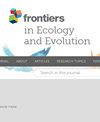基于分子条形码鉴定蚯蚓标本以评估生物多样性所面临的挑战
IF 2.4
3区 环境科学与生态学
Q2 ECOLOGY
引用次数: 0
摘要
物种水平的标本鉴定是了解群落结构和保护生物多样性的关键挑战。除形态学外,线粒体 DNA 条形码的使用已被证明是鉴定蚯蚓的有用工具,但也带来了一些困难。因此,从细胞色素 c 氧化酶亚单位 1(COI)或 16S rDNA 序列数据中划分分子操作分类单元(MOTU)的方法往往揭示出比形态物种更多的线粒体系,这就提出了在群落结构研究中是否应将这些分子操作分类单元作为分类实体的问题。在这里,我们使用了新近获得的法国大都市蚯蚓的 576 个 COI 条形码数据集,这些数据集被聚类为 36 个 MOTUS,对应 21 个形态种。我们还结合了从文献中收集的数据来研究这个问题。为了将我们的 MOTU 与已描述的线粒体系进行匹配,我们从 GenBank 和 BOLD 平台下载了参考序列。鉴于在恢复这些序列时遇到的困难,我们建议研究中描述的任何新线粒体系的命名都应与之前的工作保持一致。接下来,我们分析了文献中与我们的 MOTUs 相匹配的不同线粒体系的生物学、生态学和分子数据,以确定在物种划分方面是否存在共识。虽然研究标本主要属于蚯蚓科(Lumbricidae),而该科是研究最多的蚯蚓科之一,但往往缺乏相关数据,无法确定 MOTU 是否对应不同的物种。在修订分类法之前,在群落结构研究中,线粒体分化已通过形态差异得到证实的 MOTU 应被视为不同的分类实体。在没有形态学差异的情况下,在获得更多数据之前,我们建议在有性生殖的形态种内区分线粒体差异已被多聚焦核数据证实的 MOTU,而在孤雌生殖的情况下,MOTU 之间的生态差异是将它们视为不同分类实体的必要条件。本文章由计算机程序翻译,如有差异,请以英文原文为准。
Challenges of molecular barcode-based identification of earthworm specimens for biodiversity assessment
Specimen identification at the species level is a critical challenge for understanding community structure and conserving biodiversity. The use of mitochondrial DNA barcodes, in addition to morphology, has proven to be a useful tool for earthworm identification, but it has also raised difficulties. Thus, approaches to delineating molecular operational taxonomic units (MOTUs) from cytochrome c oxidase subunit 1 (COI) or 16S rDNA sequence data often reveal more mitochondrial lineages than morphospecies, raising the question of whether these MOTUs should be used as taxonomic entities in community structure studies. Here, we used a newly acquired dataset of 576 COI barcodes of earthworms from Metropolitan France that were clustered in 36 MOTUS, corresponding to 21 morphospecies. We also incorporated data gathered from the literature to investigate this question. In order to match our MOTUs with already-described mitochondrial lineages, we downloaded reference sequences from the GenBank and BOLD platforms. In light of the difficulties encountered in recovering these sequences, we recommend that any new mitochondrial lineage described in a study be named consistently with previous works. Next, we analyzed the biological, ecological, and molecular data available in the literature on the different mitochondrial lineages that matched our MOTUs in order to determine if there was a consensus for species delimitation. Although the study specimens mainly belong to the Lumbricidae, which is one of the most studied families of earthworms, the data are often missing to determine if the MOTUs correspond to different species. Pending revision of the taxonomy, MOTUs for which mitochondrial divergence has been confirmed by morphological differences should be considered distinct taxonomic entities in community structure studies. In the absence of morphological differences and pending more data, we propose to distinguish for these analyses, within sexually reproducing morphospecies, the MOTUs for which mitochondrial divergence has been confirmed by multilocus nuclear data, while in the case of reproduction by parthenogenesis, ecological differences between MOTUs are necessary to consider them as different taxonomic entities.
求助全文
通过发布文献求助,成功后即可免费获取论文全文。
去求助
来源期刊

Frontiers in Ecology and Evolution
Environmental Science-Ecology
CiteScore
4.00
自引率
6.70%
发文量
1143
审稿时长
12 weeks
期刊介绍:
Frontiers in Ecology and Evolution publishes rigorously peer-reviewed research across fundamental and applied sciences, to provide ecological and evolutionary insights into our natural and anthropogenic world, and how it should best be managed. Field Chief Editor Mark A. Elgar at the University of Melbourne is supported by an outstanding Editorial Board of international researchers. This multidisciplinary open-access journal is at the forefront of disseminating and communicating scientific knowledge and impactful discoveries to researchers, academics and the public worldwide.
Eminent biologist and theist Theodosius Dobzhansky’s astute observation that “Nothing in biology makes sense except in the light of evolution” has arguably even broader relevance now than when it was first penned in The American Biology Teacher in 1973. One could similarly argue that not much in evolution makes sense without recourse to ecological concepts: understanding diversity — from microbial adaptations to species assemblages — requires insights from both ecological and evolutionary disciplines. Nowadays, technological developments from other fields allow us to address unprecedented ecological and evolutionary questions of astonishing detail, impressive breadth and compelling inference.
The specialty sections of Frontiers in Ecology and Evolution will publish, under a single platform, contemporary, rigorous research, reviews, opinions, and commentaries that cover the spectrum of ecological and evolutionary inquiry, both fundamental and applied. Articles are peer-reviewed according to the Frontiers review guidelines, which evaluate manuscripts on objective editorial criteria. Through this unique, Frontiers platform for open-access publishing and research networking, Frontiers in Ecology and Evolution aims to provide colleagues and the broader community with ecological and evolutionary insights into our natural and anthropogenic world, and how it might best be managed.
 求助内容:
求助内容: 应助结果提醒方式:
应助结果提醒方式:


